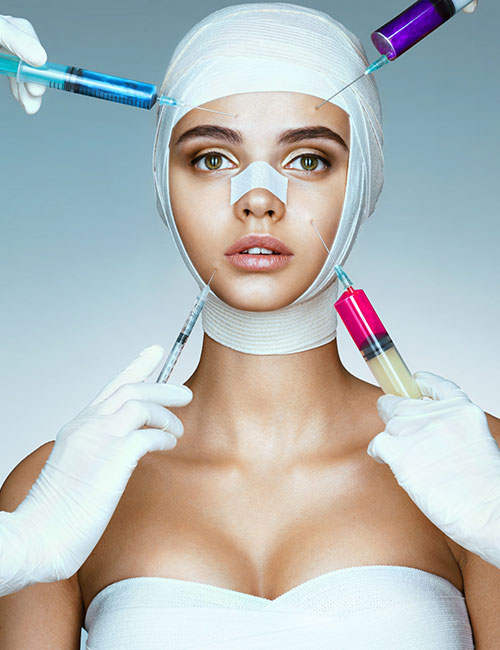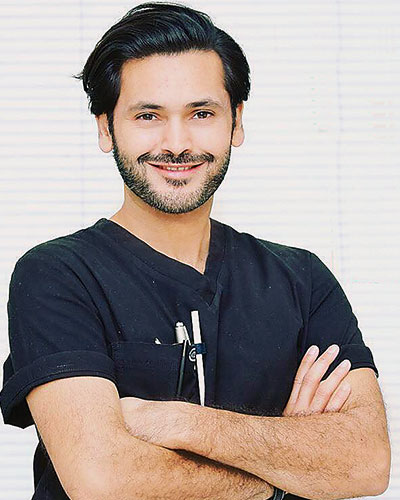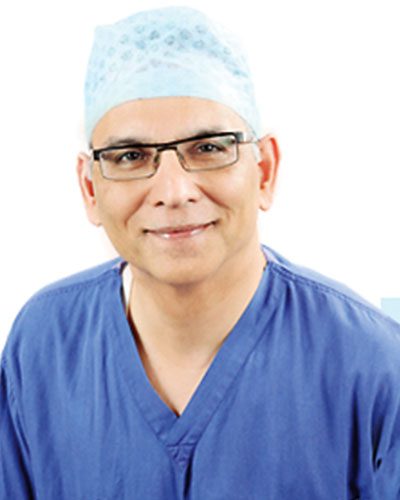DUNKI: THE PERILOUS PATH TO EUROPE
- 30 Mar - 05 Apr, 2024
Beauty standards set by the world of glamour are pushing men and women alike to opt for plastic procedures that do not bring desired results in some cases…
Once a hush-hush phenomenon, only read about in gossip columns of glossy magazines amidst of oohs and aahs, cosmetic surgery was considered an arena strictly traversed by A-list celebrities. Despite the masses’ general disengagement with the entire concept of it, one used the word with much uninhibited reasoning; a glance at a cover girl’s photoshopped lips were rationalised as “Uss ney Botox karwaya hoga”.
In the last few decades, this once intriguing and otherworldly procedure, after coming full circle in showbiz, made a quantum leap to the common populace. Now, cosmetic surgery doesn’t remain a realm too unfamiliar to most. In fact, its rampancy has almost normalised the concept. A tuck in one place, a lift in another, cosmetic procedures and techniques are all the rage globally.

Women make a beeline at cosmetic clinics, towing their young, unmarried daughters along for ear tucks and skin lightening; aspiring models seeking a “break” in their careers line-up for appointments for liposuction and nose jobs; men file in for hair transplants, while most bring in their wives for tummy tucks and facial fillers. The list is endless and the bottom-line one – cosmetic surgery has unfurled its market, and is no longer limited to the glamorous world of showbiz.
Marzia* was born with a huge mole over her right eyebrow. “For 25 years, I lived with it, but then came a point when it became a hurdle for both, my personal and professional growth,” she woes, requesting for anonymity of her last name. “One day, a friend recommended me a cosmetic surgeon. This was years back, when cosmetic surgery was newly introduced in Pakistan. I was sceptic and scared, but went ahead with it. It was hands down the best decision of my life; it gave me confidence, a new job, a prospect of marriage and so much more. I am positive that I would not have been able to live a normal life if I would not have had it operated”
Mehak recently underwent rhinoplasty (nose job). “It was traumatising being teased over my crooked nose all my childhood. I hated it! But now that I could afford getting it fixed, I went ahead with it although nobody pressurised me,” she shares.
There are many reasons calibrated to the boom of cosmetic surgeries; majorly being the use of sophisticated procedures, safer anaesthetics and the demand to appear good. The acclaim of cosmetic surgery in Pakistan may have stretched its wings, for its young flight, but it has not earned acceptance from all quarters. Many cite these surgical and non-surgical procedures as an unnecessary vanity which feeds on narcissism.
However, the mavens in the field disagree. Dr Fahad Mirza, a highly acclaimed plastic and reconstructive surgeon who is trained in Plastic and Reconstructive Surgery from Liaquat National Hospital and has practiced extensively in cosmetic surgery, disagrees with the concept. “Plastic surgery was considered as an unnecessary vanity; it was even a taboo maybe 15 or 20 years ago? But in the last 10 years or more, specifically in last five years, social media has given the masses an exposure and unrestrained access to a different life,” Fahad tells me, citing social media as a pivoting force in the acclaim of cosmetic procedures. “It (social media) has provided many with a window into the lives of several celebrities. Back then one only used to see a celebrity on a magazine cover, or on television and would wonder that perhaps this is how they look in real. But kudos to Instagram and Facebook, you have gained access to their inner lives. You see the stuff they post about their life and you come to the realisation that everybody is getting these fillers, Botox and many plastic surgery procedures done, and everybody is looking good.
“With this awareness, more people have resorted to fillers and Botox and hence the acceptance of it has largely inflated,” he says, making a confident prediction that soon the concept of unnecessary vanity in concern with cosmetic surgery will be written off too.
“I always say to people, if something is bothering you and if it can be fixed; then fix it. It is not too expensive, it has amazing results and promised longevity.”

But what harms does cosmetic surgery harbour beneath the layers of artificial youth and its promised longevity? And does one have to compromise on long term health to tick a few boxes that meet established beauty standards? Do you know the potentially grave risks that most take along with them, as they go under the knife?
Sifting through the facts provided by experts and practitioners in the field, I concluded that the most requested surgical procedures are facelift, liposuction, tummy tucks and Rhinoplasty. While the most requested cosmetic procedures in Pakistan is Botox, followed closely by facial dermal fillers.
What the renowned plastic surgeons have to say
“Asian skin has the tendency to sag rather than wrinkle. Therefore, to restore its elasticity and fullness, fillers are injected in areas like the cheeks and laugh lines,” Dr Mabroor Bhatty tells me.
Considered as the pioneer of cosmetic surgery in Pakistan, Dr Bhatty is a member of International Confederation of Plastic, Reconstructive and Aesthetic Surgeons (IPRAS). His time is consumed with busy practices in Karachi and London. Listed amongst UK's leading plastic surgeons, his major practices include facelift surgery, liposuction, tummy tucks, blethoplasty, breast augmentation, eye-bag removal and non-surgical procedures. I ask Dr Mabroor Bhatty, about the most common procedure in the circles; what exactly is a “filler”?
“It is a gel-like synthetic material injected under the skin in order to plump it up, or raise the skin, eradicate facial wrinkles and restore the smooth appearance of skin. It dissolves by itself, normally within a year, and thus requires topping up at least once a year,” Dr Bhatty explains.
Botox treatments
“Botox has emerged as an effective treatment for people undergoing depression, because it lends a positive impact to the victim’s psyche,” Dr Mirza tells me. “Of course there are ridiculous exceptions, when there are young girls who come up to me asking for sharp cheekbones, a sculpted jawline, a jutting chin or a change in their appearance,” recounts the surgeon. “I suggest them to mull over, telling them it’s a long process and one that constantly requires you to maintain yourself. But if it is a question of rejuvenating yourself or to maintain your youth; it's best to go for it.”
“A plastic surgeon is a culmination of an artist and a surgeon. A good plastic surgeon is one who has great surgical and artistic abilities,” opined Dr Mirza, over what makes a doctor a good plastic surgeon.
“You will do disservice to your patient if you end up making them look worse than they started with. In cosmetic surgery there is zero margin of error since you have patients who seek to improve their immediate appearance,” he says, suggesting that even in a reconstructive surgery, like burnt face or tumour removal, there is a lot of margin in ‘just doing a job’.
“As a plastic surgeon,” says Dr Mirza, “we were taught to ‘mark thrice, plan twice and cut once’, so yeah good plastic surgeon is the one, who is dedicated to his work and patients.”
“One needs to be able to cut and stitch well, to start with,” says Dr Bhatty. “Imagination, creative mind and dire respect for the tissues are some of the perquisites of becoming a good plastic surgeon.”

The pulsing and constantly evolving cosmetic procedures and practitioners have to vet through different school of thoughts in their wake. One is the sentiment expressed by many who think the natural ageing process should not be altered or interrupted with. “There is a saying in our society that growing old is not an option but looking old certainly is,” comments Dr Mirza. “Everybody has a right to feel good and rejuvenated about themselves. If there are safe, effective and cost effective options that can restore your youth and freshen up your appearance, so why not go for it?,” he questions. “I know many people who garnered their lost confidence by beautifying themselves; when you know you look good, you are confident. And if you are confident, you perform better at work, in your relationships, with your friends and you perform better in life, generally. See it as investing in your appearance.”
I asked Dr Mirza about the other benefits, apart from an improved physical appearance, a doctor identifies in patients who have undergone cosmetic or reconstructive surgery. “A person’s physical appearance is tied to their sense of self, self-esteem and confidence; when your physical appearance improves, your self-esteem and confidence are inflated. A good physical appearance has psychological effects, deep inside.”
Is plastic surgery a viable solution for all? The surgeons shed light
Is there any important, comprehensive conversation a plastic surgeon must have with the patient, prior to the surgery? Are there times when plastic surgeons have (and should) decline a client because they don’t feel the procedure is a right thing to do? How important is this conversation? One answer: it’s crucial.
For Dr Mirza it all begins with a reflective conversation with his patients, where he asks about the particular feature of their face or body which they want to get operated. “The best patient is the one who already knows their problematic areas and its solution, in a realistic manner.
It is crucial to ask the patients about their motivations behind getting the procedure done. If the motivation is unrighteous, there are always problems which follow,” says Dr Mirza.
Dr Bhatty, too, stresses the crucial importance of having a detailed chat with patients before the surgery. “I have a serious talk with the patient before deciding on any procedure, I try to assess the problem and how concerned the patient is about it. And whether the concern is not out of proportion and that they are not suffering from body dysmorphea, where they just do not like their body parts and want to have surgeries all the time to make it better,” he clarifies.
A significant ratio of Dr Bhatty’s practice is dedicated to body contouring, requested by many patients who undergo massive weight loss. How important it is to have a plastic surgeon devoted to this sub-specialty, I ask the surgeon. “Once a person loses weight, they are commonly left with excess skin which sags and hinders them from taking part in daily routines,” he explains. “By re-contouring their bodies, one can give them their life back. It helps the patients enjoy the rewards of weight loss and help them through this final stage and regaining one’s sense of self.”
Despite the insistence of exceptional research, its acclaim and the progress of plastic surgery in all quarters, it will always foster a darker, nastier and unilluminated side. There are infamous examples which paint the perils of cosmetic surgery very clearly for us. Micheal Jackson’s notorious physical transformation, speculations about Sridevi’s untimely death tied to cosmetic procedures and a plethora of celebrity surgeries gone wrong, suggest that often the associated risks are much unbiased in their wake to sabotage who they can.
Michael Jackson: The pop singing sensation started with a modest desire to have a different nose. By the time he approached his late 40s, the star underwent up to 100 procedures, desperately trying to repair the damage done by reckless and botched operations and injections. After a span of three decades spent trying to achieve his idea of perfection, the singer succumbed.
Sridevi: The Chandni actress was rumoured to have gone under the knife in the 90’s for a nose job; the actress’ first cosmetic surgery. After which the actress underwent a myriad of other cosmetic procedures to appear more youthful, including facial enhancement, facelifts, liposuction, Botox and breast implants. At 50 years, Sridevi still appeared as youthful as her debut days in the film industry. Her unexpected death, coaxed many to examine how deeply the surgeries fragmented her from within, while she exuded grace and eternal beauty from the exterior. The crash diet which she was on, aiming for a size zero figure, coupled with the physiological stress from the surgeries, didn’t help her case either.
Sajid Hasan: In February this year, the veteran Pakistani actor Sajid Hasan experienced a distressing incident of hair transplant gone wrong. According to the actor, he was coerced by an acquaintance, who was also a doctor, for several years to get a hair transplant done from him. Prior to the surgery, he found it strange that no medical tests were conducted. A day after the hair transplant, Hasan developed an infection on his head and had severe fever for 10 days. Upon complaining, the surgeon would tell Hasan that this is a normal ordeal underwent by any who get a hair transplant done and kept cleaning his wound with saline water. This led to his wounds getting further infected; the actor then had to get a scalp reconstructive surgery done by Dr Fahad Mirza.
Jocelyn Wildenstein: Called the poster girl for cosmetic surgeries gone wrong, and dubbed “Catwoman” by the media, Wildenstein is an American socialite known for her extensive experiments with cosmetic procedures. The socialite is rumoured to have spent $4 million on cosmetic surgeries to elicit a more cat-like look, to please her ex-husband who was fond of big cats. She has undergone canthopexy, a procedure that elevates the eyes to give them a cat-like appearance, along with an upper and lower eyelid surgery, a brow-lift, face-lift, lip-plumping injections, chin augmentation, fat grafting and cheek implants.
Donatella Versace: The Italian fashion designer, spearheading the powerhouse brand Versace transformed herself into a human waxwork with Botox, implants and laser resurfacing. Her overly plump upper lip and waxy skin has been the talk of the town, for all the formidable reasons.
RHINOPLASTY: Known as ‘nose job’, rhinoplasty is a procedure most people are familiar with, calibrated to its rampancy in the showbiz. Rather unrestrained, its exaltation has seeped into the common populace. But behind a crooked, bulbous nose which undergoes a Pinocchio’s metamorphosis overnight into a ridiculously perfect aquiline or button nose, isn’t an “overnight” phenomenon after all. But this is not usually what an A-list model would tell you, rather they’d deny it.
The procedure: A corrective Rhinoplasty correct bumps and/or changes the angle or alters the tip of the nose. Depending on the request made by an individual, in most cases cartilage and bone may be removed too.
The associated risks: Excessive bleeding, holes in the septum, skin necrosis, fatal infection, nasal blockage and complications of anaesthesia, are a few risks to count. Aside, it can also be possible that your new nose, may not be what you wanted and for which you went under the knife.
RHYTIDECTOMY: Commonly known as facelift, rhytidectomy is another most sought surgical procedure which improves visible signs of aging in the face and neck.
The procedure: It counters the loss of youthful contours in the face including relaxation of the skin of the face causing the sagging, removal of laughing lines and excess fat of the neck that can appear as a double chin or "turkey neck", brow lifts, eyelid surgery to rejuvenate aging eyes and much more.
The associated risks: If gone wrong, the risks of face-lift are quiet alarming. Hematoma is the most common complication after a facelift and may occur in 1-6 percent of breast augmentation procedures. It is a pocket of blood that resembles a large, painful bruise which causes visible inflammation including pain, swelling, and redness. In many cases, in the occurrence of hematoma a patient may have to undergo additional operations to drain the clotted blood within the tissues. And then, comes the horrible risk of facelifts gone wrong. In some cases a surgical error can be rectified through additional procedures by a plastic surgeon. But, some surgical errors can lead to permanent injury or even death. Facelifts errors may occur when a plastic surgeon implements poor surgical technique or substandard care during the surgical procedure, resulting in infections, nerve damage, permanent scarring and other critical conditions. The most common risks for breast augmentation – the most requested plastic surgery in Pakistan – includes bleeding, changes in breast sensation, and faulty position of the implant, persistent pain and possibility of revision surgery.
ABDOMINOPLASTY: Also known as a tummy tuck, abdominoplasty harbours the highest risk of major complications in contrast with other types of cosmetic surgery.
The associated risks: Scarring, hematoma, blood clots, fat necrosis, asymmetry and numbness are a few associated risks. A major surgery like, tummy tucks requires the expertise of a highly qualified plastic surgeon, one who has been practicing for an extensive period.
COMMENTS